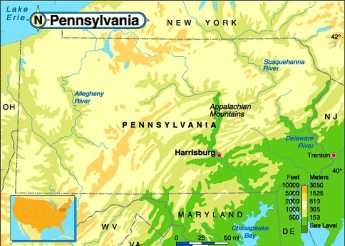Related Topics
Central Pennsylvania
"Alabama in-between," snickered James Carville, "Philadelphia, Pittsburgh, and Alabama in-between."
Appalachian Geography
Let's sketch the geographical skeleton of eastern North America as a strip of land from the Arctic Ocean, down through Central Pennsylvania, to the Chesapeake Bay. The Bay is essentially a southern continuation of the Susquehanna River so this area might be described as the Susquehanna watershed, extended.

|
| Keystone State Water Ways |
Cold air blows down from the Arctic to the Great Lakes where it picks up a lot of water, which then gets dumped on the snow belt of Upstate New York, as well as on the formerly glaciated mountain basins of the Appalachian mountains of Pennsylvania. Geologically, this once created a large inland sea, until the water broke through the mountains through four main water gaps. The most obvious ones are at Pittsburgh, West Point NY, and the Delaware Water Gap. The Susquehanna is so large it has several water gaps, notably above Harrisburg, at Northumberland, and Sayre. This huge drainage area percolates streams down the North-South mountain ranges, flowing into progressively larger river branches which finally drain into the Northern tip of Chesapeake Bay, and thence out to sea at Norfolk VA. The mountainous areas are several hundred miles wide, so the western collection area flows into the Allegheny River and down to the Mississippi, while the Eastern mountain area collects water that flows into the Delaware River and out the Delaware Bay. Since the mountain ranges bend to the East above Pennsylvania, there is even a Northern runoff draining into the Mohawk and Hudson River basins. This huge water-collecting system thus fills four major rivers along the Atlantic coast, and along with astonishingly deep winter snowfalls pumps major amounts of fresh water out to sea. The central river system in this whole area is the Susquehanna. As far as bird migration is concerned, it extends up to the Arctic Ocean, and a few bird species go on South to Patagonia. The birds are up where you don't see them much, but the quantity of bird life is huge. At one time, the fish migration was equally immense.
At the moment, there is a strip more than a hundred miles wide, covered with a forest of mixed hardwood and conifers; there are little towns and a few fairly big ones, but large stretches where ten persons per square mile would seem populous. Because of the recent boom of shale gas prosperity, most of the houses which were sort of tumble-down and in need of paint five years ago, now look brand new. Some of these houses are prefabricated, many were probably only reshingled with new siding in the past couple of years, but they look new to a passing tourist. The roads are mostly quite good, looking recently repaved and graded. There are hundreds, possibly thousands, of trucks hauling pipe and wastewater for the comparatively simple process of pumping in water, to drive out the pockets of gas, and then collecting the gas in pipelines.
Naturally the sudden gold rush, or shale gas rush, excites two varieties of comment: about the great good luck for the locals, and about the drastic threat to the environment. This is the forest primeval, but it won't be primeval for much longer, goes the lament. But there is a third sort of reaction, which only emerges slowly, after learning that vast areas of this pristine forest were burned to the ground in 1910, just one century ago. During most of the Nineteenth century, the main industry had been logging. Paul Bunyan lumberjack stories abounded at the time of the First World War, as the trees were cut, collected, and floated down various rivers in the spring log rafts. Railroad ties were a large destination for such wood and houses and barns for new settlers. The really tall and straight logs were floated down and around to Camden, where they became the masts of ships. It is said a major battleship of the Revolutionary period might consume 800 trees. But those big trees had been shading and protecting the smaller ones; once the big ones were gone, the region became vulnerable to forest fires. Major forest fires even destroyed the topsoil by erosion, after first burning off the protective understory. The long and the short of it is that this place was a virtual desert in 1910. It may have been a primeval forest before the lumberjacks arrived, but it was only a burned out desert within the memory of our grandparents. So even if the shale gas industry ruins the landscape a second time, turning scattered settlers into near-millionaires and all of those other exaggerated reactions, pro, and con, it may not be so bad. The forest spontaneously recovered from worse devastation than that, only fifty years ago. As a matter of fact, it has gone through three ice ages in the comparatively brief interval of 20,000 years, grinding those craggy ridges down to graceful bowls. That's no reason to be careless and profligate. But it's doubtful that environmental conditions will ever be as bad again as they were, only a century ago.
Originally published: Tuesday, August 02, 2011; most-recently modified: Monday, May 13, 2019